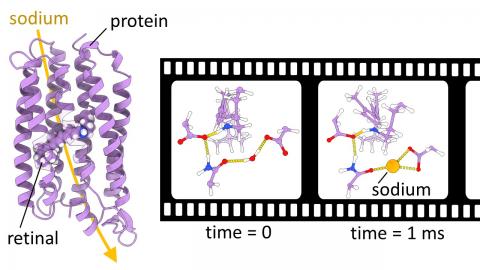Krokinobacter eikastus rhodopsin 2 (KR2) is a light-driven sodium pump that actively transports small cations across cellular membranes. Such pumps are used by microbes to convert light into a membrane potential and have become useful optogenetic tools with applications in neuroscience.

An interdisciplinary consortium has applied time-resolved serial femtosecond crystallography to study the pumping process in KR2. The team of Dr. Jörg Standfuss (Paul Scherer Institute, Switzerland) has obtained high-resolution snapshots throughout the KR2 photocycle, which visualized sodium translocation over time. However, the sodium ion has the same number of electrons as a water molecule and is therefore difficult to differentiate in crystallographic data. Hence, Rajiv K. Kar and Igor Schapiro used the hybrid QM/MM method in ChemShell to assign the position to a sodium ion or a water molecule.
The QM/MM simulations both refined the structure and computed spectroscopic parameters. This allowed the precise assignment of either sodium or water to the experimental electron density. These calculations were instrumental to resolve transient binding sites of sodium and the involved key amino acids. These results provide a direct molecular insight into the dynamics of cation transport across biological membranes.
P. Skopintsev, D. Ehrenberg, T. Weinert, et al., “Femtosecond-to-millisecond structural changes in a light-driven sodium pump“, Nature, 2020. DOI: 10.1038/s41586-020-2307-8
